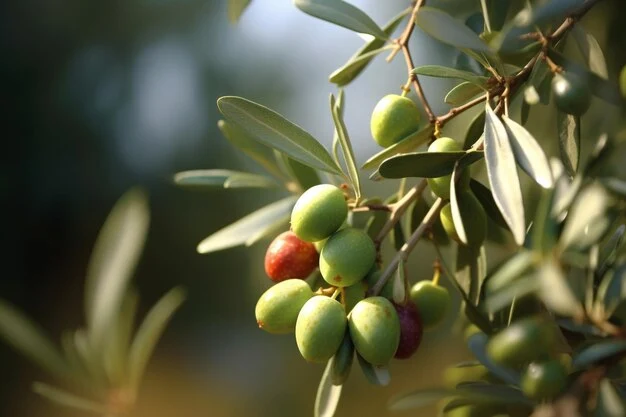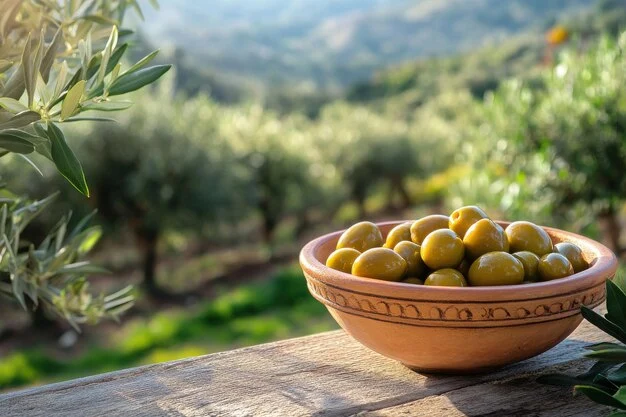Green olives are more than simply a dish; they have long been a fixture in kitchens all around the world. Why? They have a distinct flavor and are very healthful. Green olives have a fascinating history that begins in the sunny Mediterranean, where they have been farmed for ages, and ends on our tables. From the farm to your plate, let's take a tour of that journey together.
Where Green Olives Come From
The majority of green olives are imported from sunny, warm regions such as Greece, Turkey, Italy, and Spain. These nations are well-known for cultivating olives due to their ideal climate, which consists of scorching summers and moderate winters. The trees enjoy this type of weather and grow robust, producing some of the best olives in the world.
Varieties of Green Olives
The flavor of green olives varies. Some of them, like the Manzanilla olive that's frequently found in appetizers, are mild and nutty. Next is the French Picholine, which is a tad harder and with a hint of acidity. And for a sweet treat, try the buttery, sweet Castelvetrano from Italy. Because each has a distinct flavor, eating them is a lot of fun.
Growing and Harvesting Olives

Olive trees are hardy and have a lengthy lifespan—up to several hundred years! Farmers sow them in soil that drains well and receives lots of sunlight. Although the trees don't require much water, it's still vital to manage it properly, particularly in arid regions. Farmers utilize drip irrigation, which gives the trees just enough water, to save water.
Green olives are harvested in early fall, before they ripen completely. To maintain their impeccable appearance, they are occasionally hand-picked, especially the more expensive ones. Alternatively, larger farms use faster machines that shake the olive trees to remove the fruit.
How Green Olives Become Edible
You wouldn't want to eat a freshly plucked green olive straight off the tree because they are really bitter! Therefore, in order to eliminate that bitterness, they must be treated. There are several approaches to this:
-
Olives are soaked in saltwater for several months to cure in brine.
-
Lye curing: A speedier technique for reducing bitterness with lye.
-
Dry curing: Olives are cured with salt, which frequently causes them to wrinkle.
-
Olives go through fermentation following curing. Depending on the process, this stage can take weeks or even months to fully bring out their flavor. Once that’s done, they’re ready to be packaged and distributed to stores.
A Tradition of Farming for Centuries
For millennia, olive cultivation has been an integral part of agricultural customs in Spain and Italy. Over time, both nations have refined their farming methods, resulting in a steady supply of premium olives.
-
Tradition in Italy: Olives were grown as a food source and also served as a symbol of peace and wealth in Ancient Rome, where olive farming originated. Italians have created a wide variety of olive oils over the ages, reflecting the country's varied topography. Common in places like Tuscany, terraced farming makes the most use of the land in steep terrain, giving trees more exposure to the sun.
-
Spain's heritage: Olives have been a mainstay in Spain since the Phoenicians brought them there approximately a thousand years ago. Roman and subsequently Moorish influence further strengthened this heritage. Spanish farmers have passed down olive-growing techniques from generation to generation, notably in Andalusia, where families have been cultivating olives for hundreds of years. The rigorous pruning techniques and deliberate variety selection guarantee continuously high-quality Spanish green olives.
Culture of Olive Cultivation
Olives are more than just an agricultural product in Spain and Italy; they are a staple of Mediterranean cuisine and a cultural emblem.
-
In Italy, the culture of olive oil and olives is strongly integrated into daily life. Small olive groves are frequently owned by families, and gathering together for "la raccolta," or the harvest, every year is a long-standing custom. Freshly harvested green olives are fundamental to regional Italian recipes, especially in Southern Italy.
-
Olives are equally embedded in Spanish culture, where they are utilized in cooking and offered as tapas. Festivals celebrating the olive harvest, such as the Fiesta de la Aceituna in Baena, Andalusia, illustrate the cultural significance of olives. The affection that the Spanish have for olives is evident in their distinctive ways of preparing and curing the fruit, which retain its original flavor while incorporating a distinctively local flair.
Read Also: Tips for a DIY Aquarium That Fights Mosquitoes
Rich History of Green Olive Cultivation

Growing green olives for a long time has led to a wealth of knowledge about the finest kinds, harvesting methods, and processing procedures in Italy and Spain. A quick overview of green olive farming throughout history is provided below:
-
Italy's History: The Etruscans began cultivating olives in Italy around 800 BC, and the Romans followed suit, spreading olive groves throughout the Roman Empire. Some of the planting, pruning, and pressing methods for olives that were described in ancient literature by Roman agriculturalists are still in use today. Italian olive growers have meticulously preserved historic groves with trees that are hundreds, even thousands of years old, especially in areas like Puglia.
-
Spain's History: The country's Moorish heritage is strongly connected to its history of green olives. The Moors introduced excellent irrigation and olive farming techniques when they governed Spain from the 8th to 15th century. Olive farming had a tremendous upsurge at this time, especially in Andalusia, which is still the center of Spanish olive production today. Some of the oldest olive groves in the world are found in Spain, where growers combine contemporary technology with several age-old methods.
Health Benefit of Green Olives
Green olives are a nutrient-dense addition to your diet because of their many health advantages. Here are a few of the main advantages:
1. Packed with Good Fats
Monounsaturated fats, particularly oleic acid, which is believed to enhance heart health, are abundant in green olives. By lowering bad cholesterol (LDL) and raising good cholesterol (HDL), these healthy fats can help lessen the risk of heart disease.
2. Packed Full with Antioxidants
Strong antioxidants found in olives, such as polyphenols and vitamin E, aid in the body's battle against free radicals. These antioxidants lessen inflammation, shield cells from harm, and may even minimize the chance of developing long-term illnesses like cancer.
3. Encourages Heart Health
The chemicals in green olives improve heart health by lowering blood pressure and raising cholesterol levels. Antioxidants and good fats have the added benefit of reducing the risk of atherosclerosis, or the accumulation of fatty deposits in the arteries.
4. Beneficial for Digestion
The high fiber content of green olives facilitates better digestion and helps ward off constipation. They can maintain a healthy stomach by encouraging frequent bowel motions and feeding beneficial gut flora.
5. Boosts the Defenses
A robust immune system depends on green olives' high vitamin E concentration. This vitamin strengthens the body's defenses against infections and helps shield cells from oxidative damage.
6. Encourages Bone Health
Small levels of calcium and polyphenols found in green olives help to strengthen bones. Furthermore, as you age, the anti-inflammatory properties of olives may aid in the prevention of bone disorders like osteoporosis.
7. Could Lower Risk of Cancer
The antioxidants and anti-inflammatory substances in green olives can reduce the risk of some cancers by battling oxidative stress and chronic inflammation, both of which are connected to cancer development.
8. Encourages Skin Health
Green olives can help skin health by shielding it from premature aging brought on by pollution and sun exposure because they contain vitamin E and other antioxidants. The skin is nourished and kept hydrated by the healthy fats.
9. Promotes Healthy Weight Management
Green olives, despite their high fat content, may aid in weight management because their fiber and beneficial fats prolong feelings of fullness, which in turn lessens cravings for harmful snacks.
10. Aids in Blood Sugar Control
Green olives' monounsaturated fats may enhance insulin sensitivity, which is crucial for blood sugar regulation. Those who have type 2 diabetes or are at risk for it would particularly benefit from this benefit.
In addition to being a delicious garnish for many meals, green olives provide several health advantages. Their little but powerful superfood benefits include improved digestion, bright skin, and heart health. They should definitely be a part of your diet.







